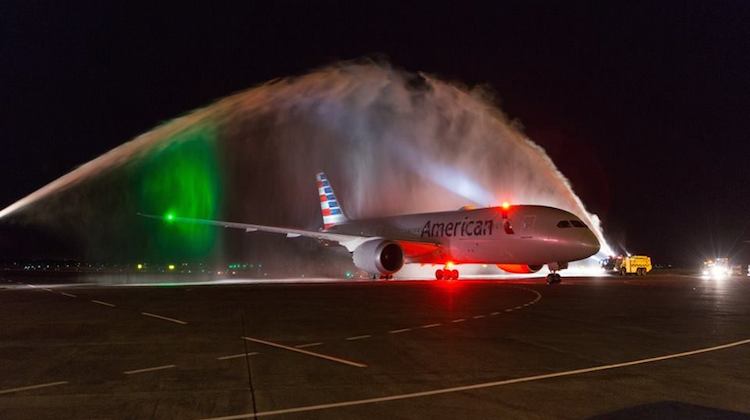
American Airlines and Qantas are finally able to forge an expanded alliance more than four years after first announcing plans to work closer together on trans-Pacific routes.
The United States Department of Transportation (DOT) has given final approval to the pair’s application for a metal-neutral, revenue-sharing joint-venture on flights between Australia, New Zealand and the United States mainland.
The two carriers have successfully reversed a prior DOT ruling in November 2016, when the department knocked back the first attempt seeking anti-trust immunity (ATI) for their joint-business agreement (JBA).
“We have concluded that, overall, the alliance and JBA will be pro-competitive and are likely to generate substantial benefits for the traveling public,” the DOT final order published on Friday (US time) said.
The final ruling followed a DOT decision in June to grant the alliance tentative approval.
The DOT said in the decision American Airlines and Qantas were required to submit a detailed self-assessment in six and a half years covering four key areas – quarterly figures on market capacity, the implementation of technological systems on revenue management and pricing systems, quarterly figures on their efforts to stimulate the market, and the level of third-party cooperation with other carriers in the market.
“The review would align with the Australian Competition and Consumer Commission’s re-authorization review and thus reduce the regulatory burden on the Joint Applicants,” the DOT final order said.
In addition to the detailed self-assessment, American Airlines and Qantas were required to submit an annual report based on those same four key areas.
Further, Qantas was required to report “full-itinerary origin-and-destination survey of airline passenger traffic for all itineraries that include a US point”.
The final decision comes more than four years since American Airlines chief executive Doug Parker and Qantas group chief executive Alan Joyce announced plans for an expanded alliance on the sidelines of the International Air Transport Association (IATA) annual general meeting in Miami in June 2015.

Qantas and American have worked closely together on the trans-Pacific market since 2011, albeit without ATI. The pair started codesharing on each other’s flights in 1989 and helped establish the oneworld alliance as founding members.
The pair competes with on the trans-Pacific market with two other alliance partnerships, the Delta Air Lines-Virgin Australia tie-up and a JV between United Airlines and Air New Zealand.
American’s decision to start flights from Los Angeles to Sydney in December 2015 – and Los Angeles to Auckland in June 2016 – prompted the two carriers to seek ATI as part of an expanded joint business agreement to reflect the US carrier’s entry into the market with its own aircraft.

In February 2016, the Australian Competition and Consumer Commission (ACCC) authorised the JV for five years, while the New Zealand Ministry of Transport gave its approval in November 2015.
However, the US DOT said in its November 2016 Show Cause Order it planned to reject the proposed tie-up between American and Qantas as it would harm competition and reduce consumer choice. In response, the pair wound back some elements of cooperation that were in place at the time that did not require ATI.
And undeterred by the setback, the two carriers submitted a fresh application in February 2018, which argued the alliance would unlock US$310 million annually in incremental consumer benefits should it be approved.
This comprised US$221 million from codeshare availability improvements and US$89 million comes from an eight per cent reduction in price per interline ticket.
There would also be a forecast 180,000 new market passengers, stimulated by additional codesharing and new flights.
However, being prevented from having deeper partnership would place at risk some trans-Pacific flights, such as Qantas’s Sydney-Dallas/Fort Worth and American’s Los Angeles-Sydney and Los Angeles-Auckland services.

In its tentative decision published in June, the DOT outlined three relevant facts and circumstances that now supported approval.
First, the DOT said market conditions had evolved since 2016, which “mitigate any competitive harm that an American/Qantas joint venture could cause”.
Second, the DOT said American Airlines and Qantas had changed the structure of their joint-venture to “address dynamics in this ultra-long-haul market”.
And third, the DOT said the pair provided extensive evidence that their joint venture plans were “likely to enhance competition and deliver new and valuable consumer benefits”.
Since the tentative decision was published, Qantas has announced plans to start Brisbane-Chicago and Brisbane-San Francisco flights with Boeing 787-9 equipment starting in April 2020. Ticket sales for the two nonstop flights have not commenced.
“The schedule for Qantas’ Brisbane-Chicago and Brisbane-San Francisco flights is being finalised, with fares available for sale soon,” Qantas said in a statement on Saturday.
Currently, the Australian carrier flies from Brisbane to Los Angeles, Sydney to Dallas/Fort Worth, Los Angeles, New York JFK and San Francisco, and Melbourne to Los Angeles and San Francisco. Its Sydney-Honolulu flights were not part of the proposed alliance.
Meanwhile, American Airlines serves Auckland (seasonal) and Sydney from Los Angeles.
American Airlines chief executive Doug Parker the ruling from the DOT was “fantastic news for our customers and team members”.
“We look forward to working closely with our valued partner, Qantas, on this new joint business,” Parker said in a statement on Friday (US time).
“We now have the opportunity to launch new routes and provide enhanced service with better schedules, additional frequent flyer benefits and continued investments in the overall customer experience.”











